Management of Health and Safety: Boeing 737 MAX Crash Analysis Report
VerifiedAdded on 2022/09/07
|11
|3042
|22
Report
AI Summary
This report analyzes the Boeing 737 MAX crashes, focusing on the management of health and safety within the aviation industry. It begins with a reflection on the flight simulations experienced by pilots, highlighting the unexpected events and the challenges they faced due to the MCAS (Maneuvering Characteristics Augmentation System). The report delves into the underlying and root causes of the crashes, including the design flaws of the MCAS, reliance on faulty sensors, lack of pilot training, and cost-cutting measures that compromised safety. It examines the impact of these failures on pilot decision-making, the regulatory environment, and the overall safety of air travel. The report also reflects on the learning gained from the assignment and its potential benefits for future practice in health and safety management, emphasizing the importance of thorough risk assessment, effective communication, and robust safety protocols to prevent similar tragedies.
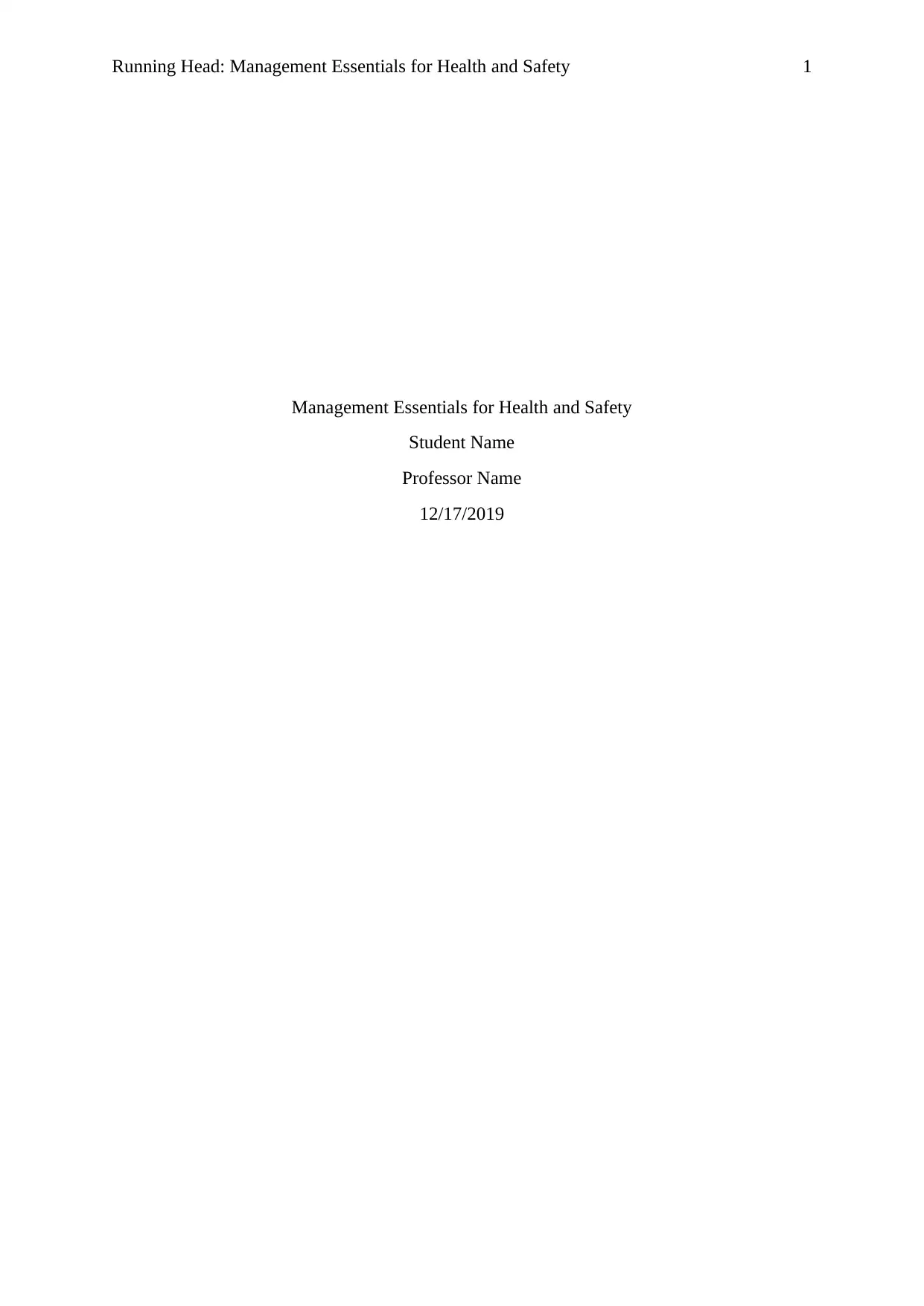
Running Head: Management Essentials for Health and Safety 1
Management Essentials for Health and Safety
Student Name
Professor Name
12/17/2019
Management Essentials for Health and Safety
Student Name
Professor Name
12/17/2019
Paraphrase This Document
Need a fresh take? Get an instant paraphrase of this document with our AI Paraphraser
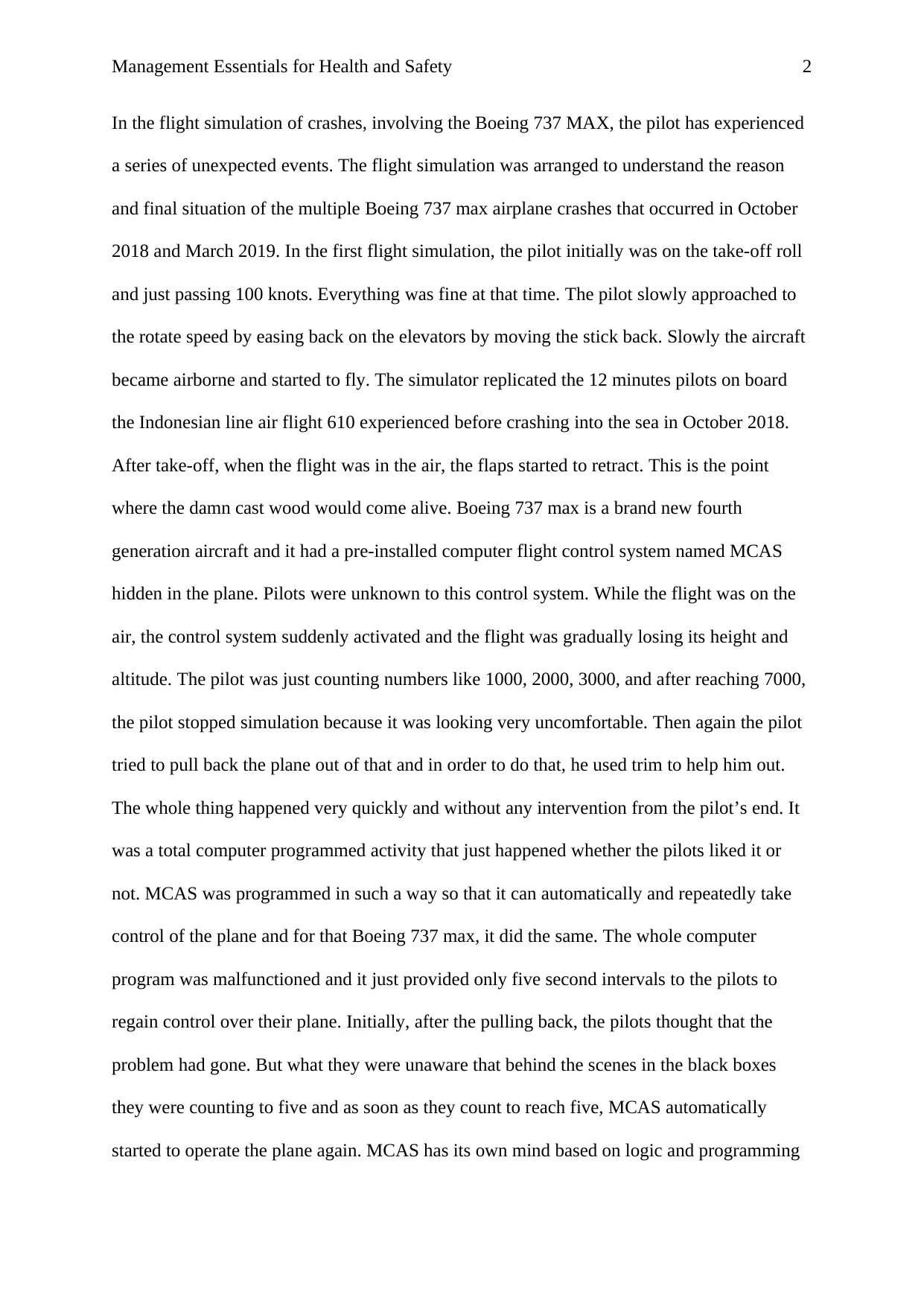
Management Essentials for Health and Safety 2
In the flight simulation of crashes, involving the Boeing 737 MAX, the pilot has experienced
a series of unexpected events. The flight simulation was arranged to understand the reason
and final situation of the multiple Boeing 737 max airplane crashes that occurred in October
2018 and March 2019. In the first flight simulation, the pilot initially was on the take-off roll
and just passing 100 knots. Everything was fine at that time. The pilot slowly approached to
the rotate speed by easing back on the elevators by moving the stick back. Slowly the aircraft
became airborne and started to fly. The simulator replicated the 12 minutes pilots on board
the Indonesian line air flight 610 experienced before crashing into the sea in October 2018.
After take-off, when the flight was in the air, the flaps started to retract. This is the point
where the damn cast wood would come alive. Boeing 737 max is a brand new fourth
generation aircraft and it had a pre-installed computer flight control system named MCAS
hidden in the plane. Pilots were unknown to this control system. While the flight was on the
air, the control system suddenly activated and the flight was gradually losing its height and
altitude. The pilot was just counting numbers like 1000, 2000, 3000, and after reaching 7000,
the pilot stopped simulation because it was looking very uncomfortable. Then again the pilot
tried to pull back the plane out of that and in order to do that, he used trim to help him out.
The whole thing happened very quickly and without any intervention from the pilot’s end. It
was a total computer programmed activity that just happened whether the pilots liked it or
not. MCAS was programmed in such a way so that it can automatically and repeatedly take
control of the plane and for that Boeing 737 max, it did the same. The whole computer
program was malfunctioned and it just provided only five second intervals to the pilots to
regain control over their plane. Initially, after the pulling back, the pilots thought that the
problem had gone. But what they were unaware that behind the scenes in the black boxes
they were counting to five and as soon as they count to reach five, MCAS automatically
started to operate the plane again. MCAS has its own mind based on logic and programming
In the flight simulation of crashes, involving the Boeing 737 MAX, the pilot has experienced
a series of unexpected events. The flight simulation was arranged to understand the reason
and final situation of the multiple Boeing 737 max airplane crashes that occurred in October
2018 and March 2019. In the first flight simulation, the pilot initially was on the take-off roll
and just passing 100 knots. Everything was fine at that time. The pilot slowly approached to
the rotate speed by easing back on the elevators by moving the stick back. Slowly the aircraft
became airborne and started to fly. The simulator replicated the 12 minutes pilots on board
the Indonesian line air flight 610 experienced before crashing into the sea in October 2018.
After take-off, when the flight was in the air, the flaps started to retract. This is the point
where the damn cast wood would come alive. Boeing 737 max is a brand new fourth
generation aircraft and it had a pre-installed computer flight control system named MCAS
hidden in the plane. Pilots were unknown to this control system. While the flight was on the
air, the control system suddenly activated and the flight was gradually losing its height and
altitude. The pilot was just counting numbers like 1000, 2000, 3000, and after reaching 7000,
the pilot stopped simulation because it was looking very uncomfortable. Then again the pilot
tried to pull back the plane out of that and in order to do that, he used trim to help him out.
The whole thing happened very quickly and without any intervention from the pilot’s end. It
was a total computer programmed activity that just happened whether the pilots liked it or
not. MCAS was programmed in such a way so that it can automatically and repeatedly take
control of the plane and for that Boeing 737 max, it did the same. The whole computer
program was malfunctioned and it just provided only five second intervals to the pilots to
regain control over their plane. Initially, after the pulling back, the pilots thought that the
problem had gone. But what they were unaware that behind the scenes in the black boxes
they were counting to five and as soon as they count to reach five, MCAS automatically
started to operate the plane again. MCAS has its own mind based on logic and programming

Management Essentials for Health and Safety 3
and for that reason, it stays on for ten seconds and then goes off for five seconds, and
continues the process repeatedly. The more heart-breaking fact is that the pilots did not know
about MCAS. It was not included in their manuals also. In the flight simulation, the pilot
Chris Brady, fought with the rouge MCAS again and again. But it was a complete one sided
battle. The plane started to trim down and the whole plane was on a very steep dive with a
constant decrease in altitude. The whole situation was very horrible even for the pilots and
they had a few seconds to take steps. The flight 610 lost communication with Air Traffic
Control and crashed into waters at 6.32 am. As per the local timeline. The plane got crashed
with an extraordinary speed. In total 189 men, women, and children died in that crash. The
whole problem occurred because of the MCAS system about which Pilots were totally
uninformed. Neither it was on their books nor did they get any training. It was like a
complete blindfold in a dark forest for the pilots. After five months of that incident, despite
Boeing’s assurances its new jet was safe, another 737 max crashes into the mountains of
Ethiopia. Its pilots fighting to the death to take control. The 10th Ethiopian airlines' flight 302
started its journey on 10th March, at 8.38 am from Addis Ababa. It was considered as one of
the safest airlines in the world. But shortly after take-off, the Ethiopian flight 302 suddenly
became out of control. A critical sensor started to send information to the plane’s new flight
control system MCAS and got malfunctioned. And as a result, MCAS started to think that the
aircraft is in a stall and literally took over the control which resulted in a steep nosedive of the
plane. The whole accident was almost identical to what happened with the line air flight 610
five months prior in Indonesia. Previously the aircraft maker company, Boeing assured the
pilots that these situations are avoidable as long as they would follow the safety checklist but
they failed to understand the complex intense emergency of the situation because the airplane
is telling that it is about to stall and that was happening right after the takeoff, within meters
of the Earth. In the second flight simulator, the pilot Chris Brady again replicated the cockpit
and for that reason, it stays on for ten seconds and then goes off for five seconds, and
continues the process repeatedly. The more heart-breaking fact is that the pilots did not know
about MCAS. It was not included in their manuals also. In the flight simulation, the pilot
Chris Brady, fought with the rouge MCAS again and again. But it was a complete one sided
battle. The plane started to trim down and the whole plane was on a very steep dive with a
constant decrease in altitude. The whole situation was very horrible even for the pilots and
they had a few seconds to take steps. The flight 610 lost communication with Air Traffic
Control and crashed into waters at 6.32 am. As per the local timeline. The plane got crashed
with an extraordinary speed. In total 189 men, women, and children died in that crash. The
whole problem occurred because of the MCAS system about which Pilots were totally
uninformed. Neither it was on their books nor did they get any training. It was like a
complete blindfold in a dark forest for the pilots. After five months of that incident, despite
Boeing’s assurances its new jet was safe, another 737 max crashes into the mountains of
Ethiopia. Its pilots fighting to the death to take control. The 10th Ethiopian airlines' flight 302
started its journey on 10th March, at 8.38 am from Addis Ababa. It was considered as one of
the safest airlines in the world. But shortly after take-off, the Ethiopian flight 302 suddenly
became out of control. A critical sensor started to send information to the plane’s new flight
control system MCAS and got malfunctioned. And as a result, MCAS started to think that the
aircraft is in a stall and literally took over the control which resulted in a steep nosedive of the
plane. The whole accident was almost identical to what happened with the line air flight 610
five months prior in Indonesia. Previously the aircraft maker company, Boeing assured the
pilots that these situations are avoidable as long as they would follow the safety checklist but
they failed to understand the complex intense emergency of the situation because the airplane
is telling that it is about to stall and that was happening right after the takeoff, within meters
of the Earth. In the second flight simulator, the pilot Chris Brady again replicated the cockpit
⊘ This is a preview!⊘
Do you want full access?
Subscribe today to unlock all pages.

Trusted by 1+ million students worldwide
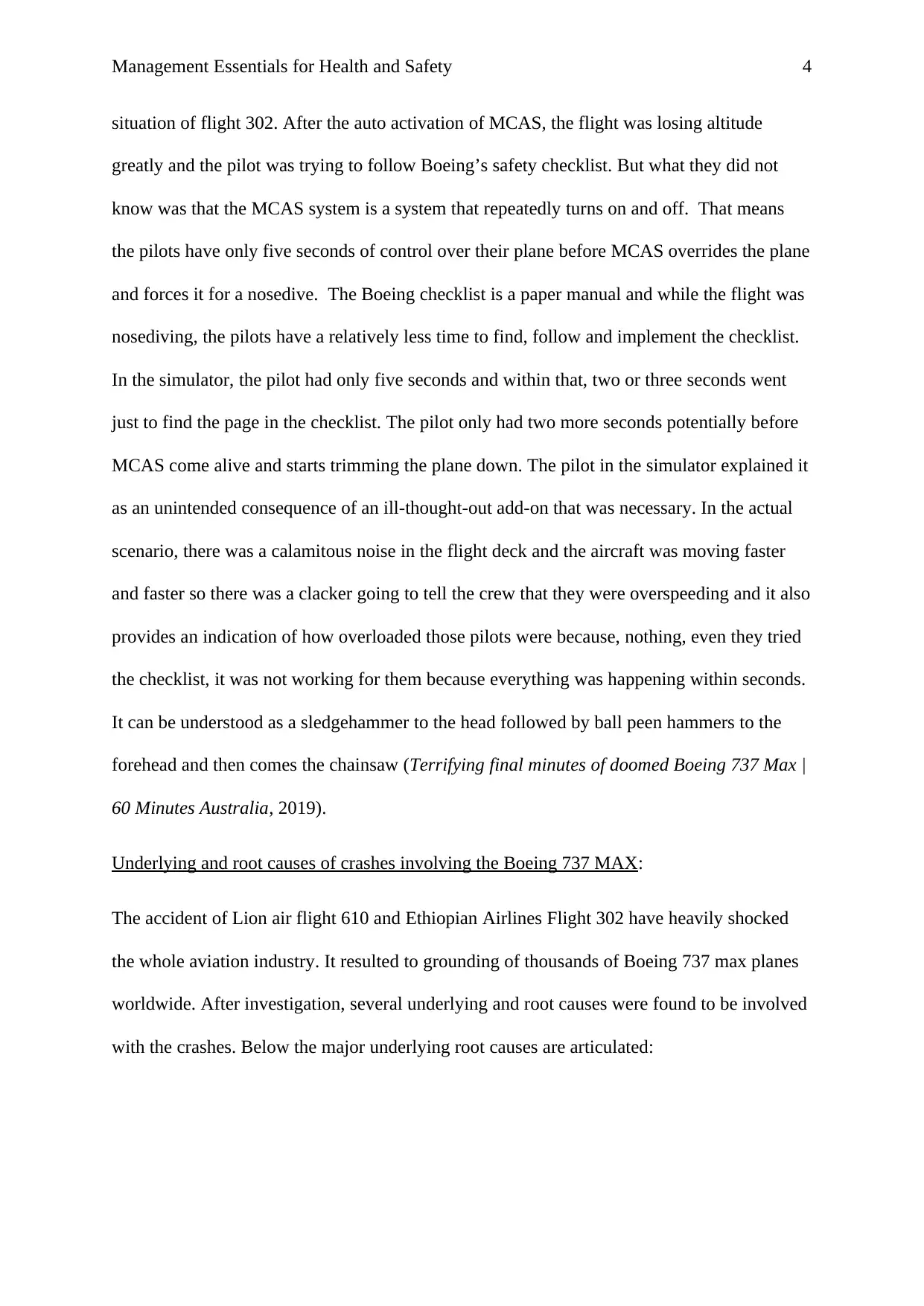
Management Essentials for Health and Safety 4
situation of flight 302. After the auto activation of MCAS, the flight was losing altitude
greatly and the pilot was trying to follow Boeing’s safety checklist. But what they did not
know was that the MCAS system is a system that repeatedly turns on and off. That means
the pilots have only five seconds of control over their plane before MCAS overrides the plane
and forces it for a nosedive. The Boeing checklist is a paper manual and while the flight was
nosediving, the pilots have a relatively less time to find, follow and implement the checklist.
In the simulator, the pilot had only five seconds and within that, two or three seconds went
just to find the page in the checklist. The pilot only had two more seconds potentially before
MCAS come alive and starts trimming the plane down. The pilot in the simulator explained it
as an unintended consequence of an ill-thought-out add-on that was necessary. In the actual
scenario, there was a calamitous noise in the flight deck and the aircraft was moving faster
and faster so there was a clacker going to tell the crew that they were overspeeding and it also
provides an indication of how overloaded those pilots were because, nothing, even they tried
the checklist, it was not working for them because everything was happening within seconds.
It can be understood as a sledgehammer to the head followed by ball peen hammers to the
forehead and then comes the chainsaw (Terrifying final minutes of doomed Boeing 737 Max |
60 Minutes Australia, 2019).
Underlying and root causes of crashes involving the Boeing 737 MAX:
The accident of Lion air flight 610 and Ethiopian Airlines Flight 302 have heavily shocked
the whole aviation industry. It resulted to grounding of thousands of Boeing 737 max planes
worldwide. After investigation, several underlying and root causes were found to be involved
with the crashes. Below the major underlying root causes are articulated:
situation of flight 302. After the auto activation of MCAS, the flight was losing altitude
greatly and the pilot was trying to follow Boeing’s safety checklist. But what they did not
know was that the MCAS system is a system that repeatedly turns on and off. That means
the pilots have only five seconds of control over their plane before MCAS overrides the plane
and forces it for a nosedive. The Boeing checklist is a paper manual and while the flight was
nosediving, the pilots have a relatively less time to find, follow and implement the checklist.
In the simulator, the pilot had only five seconds and within that, two or three seconds went
just to find the page in the checklist. The pilot only had two more seconds potentially before
MCAS come alive and starts trimming the plane down. The pilot in the simulator explained it
as an unintended consequence of an ill-thought-out add-on that was necessary. In the actual
scenario, there was a calamitous noise in the flight deck and the aircraft was moving faster
and faster so there was a clacker going to tell the crew that they were overspeeding and it also
provides an indication of how overloaded those pilots were because, nothing, even they tried
the checklist, it was not working for them because everything was happening within seconds.
It can be understood as a sledgehammer to the head followed by ball peen hammers to the
forehead and then comes the chainsaw (Terrifying final minutes of doomed Boeing 737 Max |
60 Minutes Australia, 2019).
Underlying and root causes of crashes involving the Boeing 737 MAX:
The accident of Lion air flight 610 and Ethiopian Airlines Flight 302 have heavily shocked
the whole aviation industry. It resulted to grounding of thousands of Boeing 737 max planes
worldwide. After investigation, several underlying and root causes were found to be involved
with the crashes. Below the major underlying root causes are articulated:
Paraphrase This Document
Need a fresh take? Get an instant paraphrase of this document with our AI Paraphraser
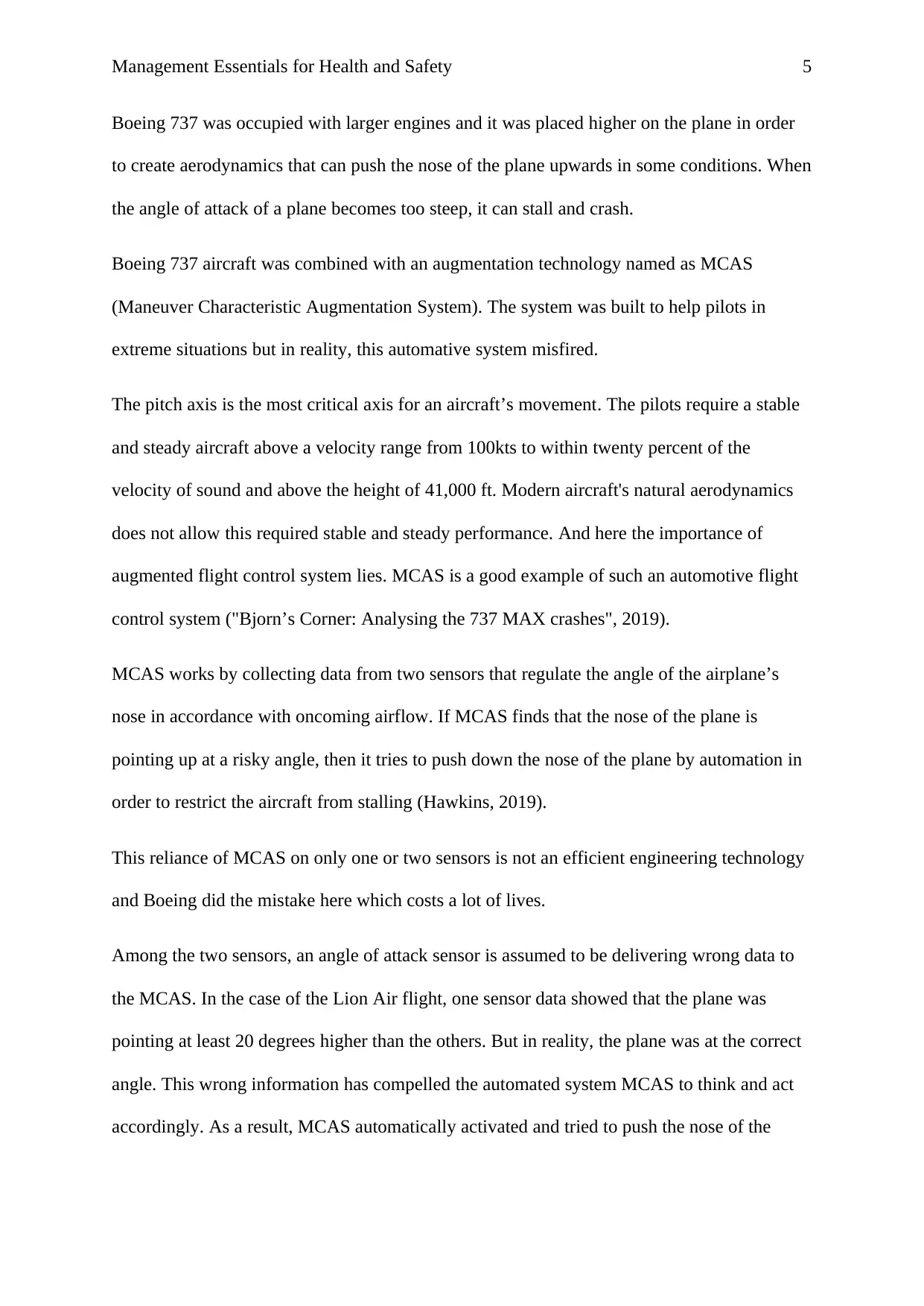
Management Essentials for Health and Safety 5
Boeing 737 was occupied with larger engines and it was placed higher on the plane in order
to create aerodynamics that can push the nose of the plane upwards in some conditions. When
the angle of attack of a plane becomes too steep, it can stall and crash.
Boeing 737 aircraft was combined with an augmentation technology named as MCAS
(Maneuver Characteristic Augmentation System). The system was built to help pilots in
extreme situations but in reality, this automative system misfired.
The pitch axis is the most critical axis for an aircraft’s movement. The pilots require a stable
and steady aircraft above a velocity range from 100kts to within twenty percent of the
velocity of sound and above the height of 41,000 ft. Modern aircraft's natural aerodynamics
does not allow this required stable and steady performance. And here the importance of
augmented flight control system lies. MCAS is a good example of such an automotive flight
control system ("Bjorn’s Corner: Analysing the 737 MAX crashes", 2019).
MCAS works by collecting data from two sensors that regulate the angle of the airplane’s
nose in accordance with oncoming airflow. If MCAS finds that the nose of the plane is
pointing up at a risky angle, then it tries to push down the nose of the plane by automation in
order to restrict the aircraft from stalling (Hawkins, 2019).
This reliance of MCAS on only one or two sensors is not an efficient engineering technology
and Boeing did the mistake here which costs a lot of lives.
Among the two sensors, an angle of attack sensor is assumed to be delivering wrong data to
the MCAS. In the case of the Lion Air flight, one sensor data showed that the plane was
pointing at least 20 degrees higher than the others. But in reality, the plane was at the correct
angle. This wrong information has compelled the automated system MCAS to think and act
accordingly. As a result, MCAS automatically activated and tried to push the nose of the
Boeing 737 was occupied with larger engines and it was placed higher on the plane in order
to create aerodynamics that can push the nose of the plane upwards in some conditions. When
the angle of attack of a plane becomes too steep, it can stall and crash.
Boeing 737 aircraft was combined with an augmentation technology named as MCAS
(Maneuver Characteristic Augmentation System). The system was built to help pilots in
extreme situations but in reality, this automative system misfired.
The pitch axis is the most critical axis for an aircraft’s movement. The pilots require a stable
and steady aircraft above a velocity range from 100kts to within twenty percent of the
velocity of sound and above the height of 41,000 ft. Modern aircraft's natural aerodynamics
does not allow this required stable and steady performance. And here the importance of
augmented flight control system lies. MCAS is a good example of such an automotive flight
control system ("Bjorn’s Corner: Analysing the 737 MAX crashes", 2019).
MCAS works by collecting data from two sensors that regulate the angle of the airplane’s
nose in accordance with oncoming airflow. If MCAS finds that the nose of the plane is
pointing up at a risky angle, then it tries to push down the nose of the plane by automation in
order to restrict the aircraft from stalling (Hawkins, 2019).
This reliance of MCAS on only one or two sensors is not an efficient engineering technology
and Boeing did the mistake here which costs a lot of lives.
Among the two sensors, an angle of attack sensor is assumed to be delivering wrong data to
the MCAS. In the case of the Lion Air flight, one sensor data showed that the plane was
pointing at least 20 degrees higher than the others. But in reality, the plane was at the correct
angle. This wrong information has compelled the automated system MCAS to think and act
accordingly. As a result, MCAS automatically activated and tried to push the nose of the
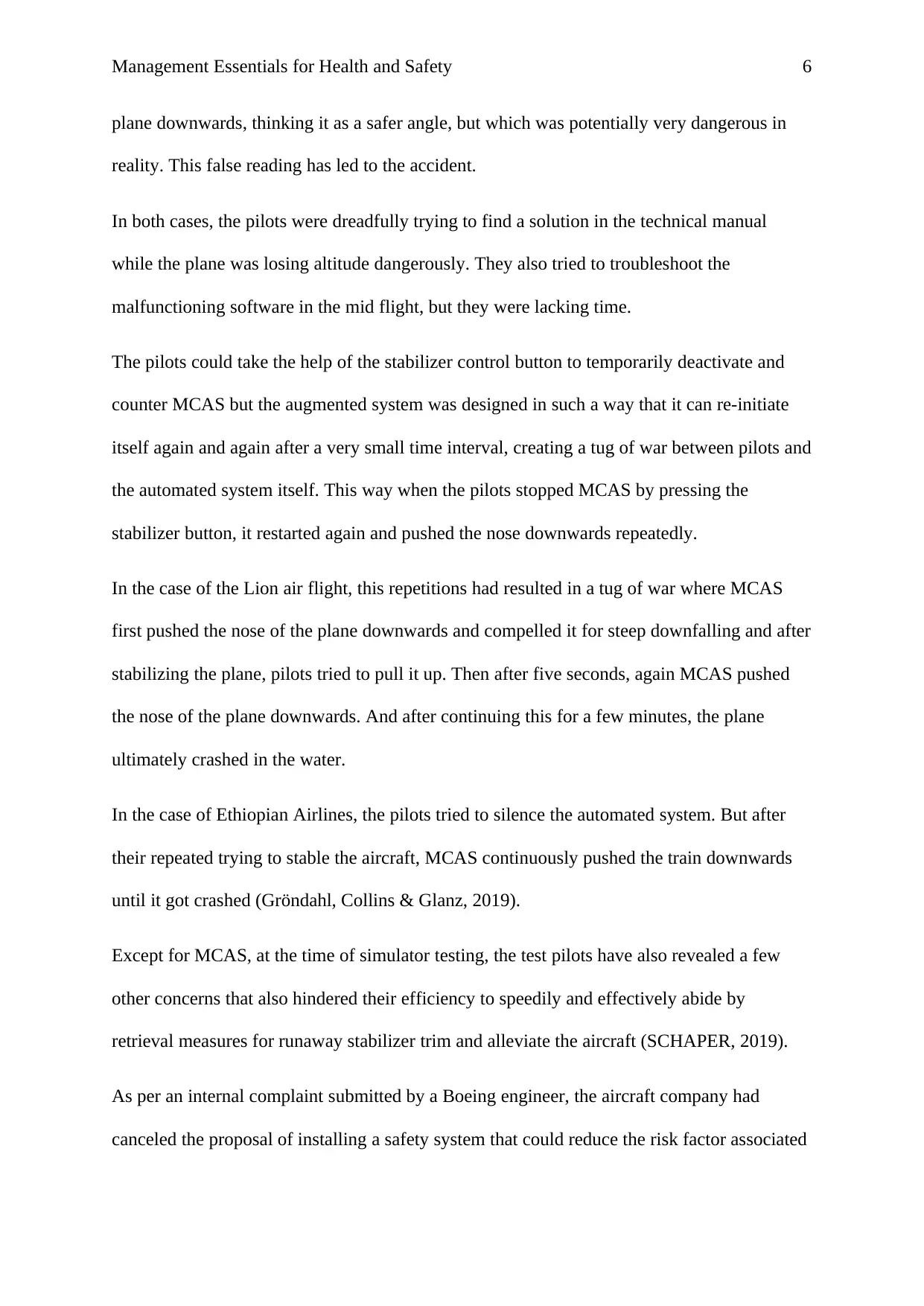
Management Essentials for Health and Safety 6
plane downwards, thinking it as a safer angle, but which was potentially very dangerous in
reality. This false reading has led to the accident.
In both cases, the pilots were dreadfully trying to find a solution in the technical manual
while the plane was losing altitude dangerously. They also tried to troubleshoot the
malfunctioning software in the mid flight, but they were lacking time.
The pilots could take the help of the stabilizer control button to temporarily deactivate and
counter MCAS but the augmented system was designed in such a way that it can re-initiate
itself again and again after a very small time interval, creating a tug of war between pilots and
the automated system itself. This way when the pilots stopped MCAS by pressing the
stabilizer button, it restarted again and pushed the nose downwards repeatedly.
In the case of the Lion air flight, this repetitions had resulted in a tug of war where MCAS
first pushed the nose of the plane downwards and compelled it for steep downfalling and after
stabilizing the plane, pilots tried to pull it up. Then after five seconds, again MCAS pushed
the nose of the plane downwards. And after continuing this for a few minutes, the plane
ultimately crashed in the water.
In the case of Ethiopian Airlines, the pilots tried to silence the automated system. But after
their repeated trying to stable the aircraft, MCAS continuously pushed the train downwards
until it got crashed (Gröndahl, Collins & Glanz, 2019).
Except for MCAS, at the time of simulator testing, the test pilots have also revealed a few
other concerns that also hindered their efficiency to speedily and effectively abide by
retrieval measures for runaway stabilizer trim and alleviate the aircraft (SCHAPER, 2019).
As per an internal complaint submitted by a Boeing engineer, the aircraft company had
canceled the proposal of installing a safety system that could reduce the risk factor associated
plane downwards, thinking it as a safer angle, but which was potentially very dangerous in
reality. This false reading has led to the accident.
In both cases, the pilots were dreadfully trying to find a solution in the technical manual
while the plane was losing altitude dangerously. They also tried to troubleshoot the
malfunctioning software in the mid flight, but they were lacking time.
The pilots could take the help of the stabilizer control button to temporarily deactivate and
counter MCAS but the augmented system was designed in such a way that it can re-initiate
itself again and again after a very small time interval, creating a tug of war between pilots and
the automated system itself. This way when the pilots stopped MCAS by pressing the
stabilizer button, it restarted again and pushed the nose downwards repeatedly.
In the case of the Lion air flight, this repetitions had resulted in a tug of war where MCAS
first pushed the nose of the plane downwards and compelled it for steep downfalling and after
stabilizing the plane, pilots tried to pull it up. Then after five seconds, again MCAS pushed
the nose of the plane downwards. And after continuing this for a few minutes, the plane
ultimately crashed in the water.
In the case of Ethiopian Airlines, the pilots tried to silence the automated system. But after
their repeated trying to stable the aircraft, MCAS continuously pushed the train downwards
until it got crashed (Gröndahl, Collins & Glanz, 2019).
Except for MCAS, at the time of simulator testing, the test pilots have also revealed a few
other concerns that also hindered their efficiency to speedily and effectively abide by
retrieval measures for runaway stabilizer trim and alleviate the aircraft (SCHAPER, 2019).
As per an internal complaint submitted by a Boeing engineer, the aircraft company had
canceled the proposal of installing a safety system that could reduce the risk factor associated
⊘ This is a preview!⊘
Do you want full access?
Subscribe today to unlock all pages.

Trusted by 1+ million students worldwide

Management Essentials for Health and Safety 7
with MCAS that resulted in two deadly crashes, only because of the cost cutting issue
(Kitroeff, Gelles & Nicas, 2019).
As per an investigation conducted by the New York Times, the officers at F.A.A never did
detailed scrutiny of the latest version of the MCAS software (Kitroeff, Gelles & Nicas, 2019).
With that, Boeing also helped in crafting regulations related to approving designs to its liking.
With that, from the findings of the professional pilots’ forum exposed that at high dynamic
pressure, Boeing 737 could experience a blowback elevator problem. Blowback elevator
problem occurs when the elevator slowly blew back to the lower and lower elevation angle
because of the pressure created by air while the speed of the plane raises. In such a scenario
the hydraulic actuators cannot cross the force of air and with time, it backs down with the
increase in the air force (Fehrm, 2019).
In a nutshell, these were the reasons for which both of the Boeing 737 max aircraft crashed
within an interval of 4 months.
Impact on learning and benefits from this assignment:
The knowledge I gained from this learning will potentially help me to understand the risks
associated with different transport systems, especially with the aviation industry. From this
assignment, I learned that how automation and augmented systems can create hazards with
the help of misleading information. I have also understood the importance of security and
safety check before approving an aircraft for flying. As per the ICAO’s strategic objectives
and policies, aviation safety is a very core and primary concept. Being a committed,
enthusiastic, and working health and safety proficient, this task has introduced me to different
safety regulations as per the ICAO’s safety report. I have learned about the Global Aviation
Safety Plan (GASP), which is the top tactical safety manuscript of ICAO. The GAS also
with MCAS that resulted in two deadly crashes, only because of the cost cutting issue
(Kitroeff, Gelles & Nicas, 2019).
As per an investigation conducted by the New York Times, the officers at F.A.A never did
detailed scrutiny of the latest version of the MCAS software (Kitroeff, Gelles & Nicas, 2019).
With that, Boeing also helped in crafting regulations related to approving designs to its liking.
With that, from the findings of the professional pilots’ forum exposed that at high dynamic
pressure, Boeing 737 could experience a blowback elevator problem. Blowback elevator
problem occurs when the elevator slowly blew back to the lower and lower elevation angle
because of the pressure created by air while the speed of the plane raises. In such a scenario
the hydraulic actuators cannot cross the force of air and with time, it backs down with the
increase in the air force (Fehrm, 2019).
In a nutshell, these were the reasons for which both of the Boeing 737 max aircraft crashed
within an interval of 4 months.
Impact on learning and benefits from this assignment:
The knowledge I gained from this learning will potentially help me to understand the risks
associated with different transport systems, especially with the aviation industry. From this
assignment, I learned that how automation and augmented systems can create hazards with
the help of misleading information. I have also understood the importance of security and
safety check before approving an aircraft for flying. As per the ICAO’s strategic objectives
and policies, aviation safety is a very core and primary concept. Being a committed,
enthusiastic, and working health and safety proficient, this task has introduced me to different
safety regulations as per the ICAO’s safety report. I have learned about the Global Aviation
Safety Plan (GASP), which is the top tactical safety manuscript of ICAO. The GAS also
Paraphrase This Document
Need a fresh take? Get an instant paraphrase of this document with our AI Paraphraser
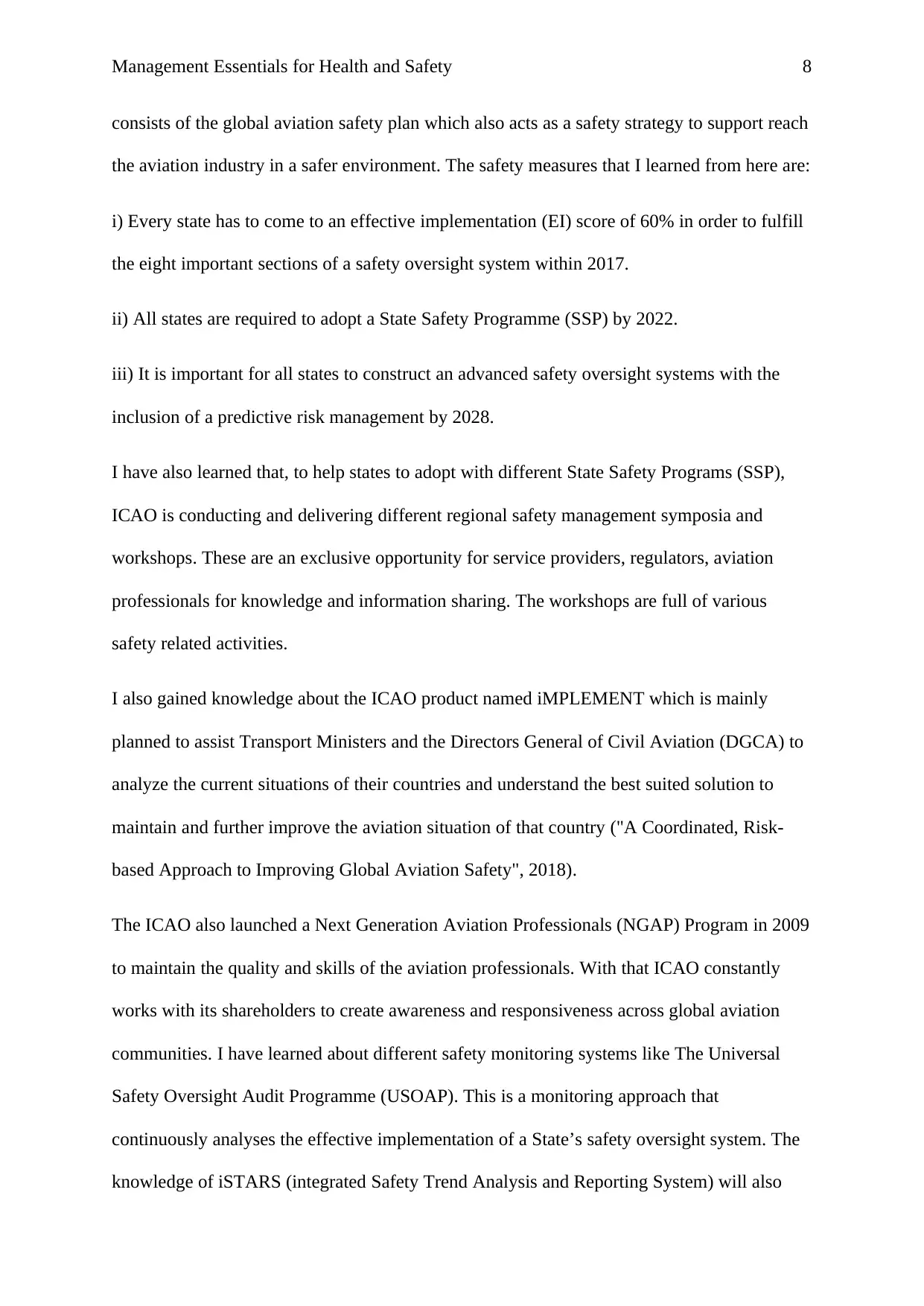
Management Essentials for Health and Safety 8
consists of the global aviation safety plan which also acts as a safety strategy to support reach
the aviation industry in a safer environment. The safety measures that I learned from here are:
i) Every state has to come to an effective implementation (EI) score of 60% in order to fulfill
the eight important sections of a safety oversight system within 2017.
ii) All states are required to adopt a State Safety Programme (SSP) by 2022.
iii) It is important for all states to construct an advanced safety oversight systems with the
inclusion of a predictive risk management by 2028.
I have also learned that, to help states to adopt with different State Safety Programs (SSP),
ICAO is conducting and delivering different regional safety management symposia and
workshops. These are an exclusive opportunity for service providers, regulators, aviation
professionals for knowledge and information sharing. The workshops are full of various
safety related activities.
I also gained knowledge about the ICAO product named iMPLEMENT which is mainly
planned to assist Transport Ministers and the Directors General of Civil Aviation (DGCA) to
analyze the current situations of their countries and understand the best suited solution to
maintain and further improve the aviation situation of that country ("A Coordinated, Risk-
based Approach to Improving Global Aviation Safety", 2018).
The ICAO also launched a Next Generation Aviation Professionals (NGAP) Program in 2009
to maintain the quality and skills of the aviation professionals. With that ICAO constantly
works with its shareholders to create awareness and responsiveness across global aviation
communities. I have learned about different safety monitoring systems like The Universal
Safety Oversight Audit Programme (USOAP). This is a monitoring approach that
continuously analyses the effective implementation of a State’s safety oversight system. The
knowledge of iSTARS (integrated Safety Trend Analysis and Reporting System) will also
consists of the global aviation safety plan which also acts as a safety strategy to support reach
the aviation industry in a safer environment. The safety measures that I learned from here are:
i) Every state has to come to an effective implementation (EI) score of 60% in order to fulfill
the eight important sections of a safety oversight system within 2017.
ii) All states are required to adopt a State Safety Programme (SSP) by 2022.
iii) It is important for all states to construct an advanced safety oversight systems with the
inclusion of a predictive risk management by 2028.
I have also learned that, to help states to adopt with different State Safety Programs (SSP),
ICAO is conducting and delivering different regional safety management symposia and
workshops. These are an exclusive opportunity for service providers, regulators, aviation
professionals for knowledge and information sharing. The workshops are full of various
safety related activities.
I also gained knowledge about the ICAO product named iMPLEMENT which is mainly
planned to assist Transport Ministers and the Directors General of Civil Aviation (DGCA) to
analyze the current situations of their countries and understand the best suited solution to
maintain and further improve the aviation situation of that country ("A Coordinated, Risk-
based Approach to Improving Global Aviation Safety", 2018).
The ICAO also launched a Next Generation Aviation Professionals (NGAP) Program in 2009
to maintain the quality and skills of the aviation professionals. With that ICAO constantly
works with its shareholders to create awareness and responsiveness across global aviation
communities. I have learned about different safety monitoring systems like The Universal
Safety Oversight Audit Programme (USOAP). This is a monitoring approach that
continuously analyses the effective implementation of a State’s safety oversight system. The
knowledge of iSTARS (integrated Safety Trend Analysis and Reporting System) will also

Management Essentials for Health and Safety 9
enrich me to understand the web-based system of ICAO which safeguards various database
and portals which simplify and support users in conducting aviation safety. These safety
regulations will help me to create a safe and conscious mind and help me practice safety
guidelines more efficiently in my professional field of work.
enrich me to understand the web-based system of ICAO which safeguards various database
and portals which simplify and support users in conducting aviation safety. These safety
regulations will help me to create a safe and conscious mind and help me practice safety
guidelines more efficiently in my professional field of work.
⊘ This is a preview!⊘
Do you want full access?
Subscribe today to unlock all pages.

Trusted by 1+ million students worldwide
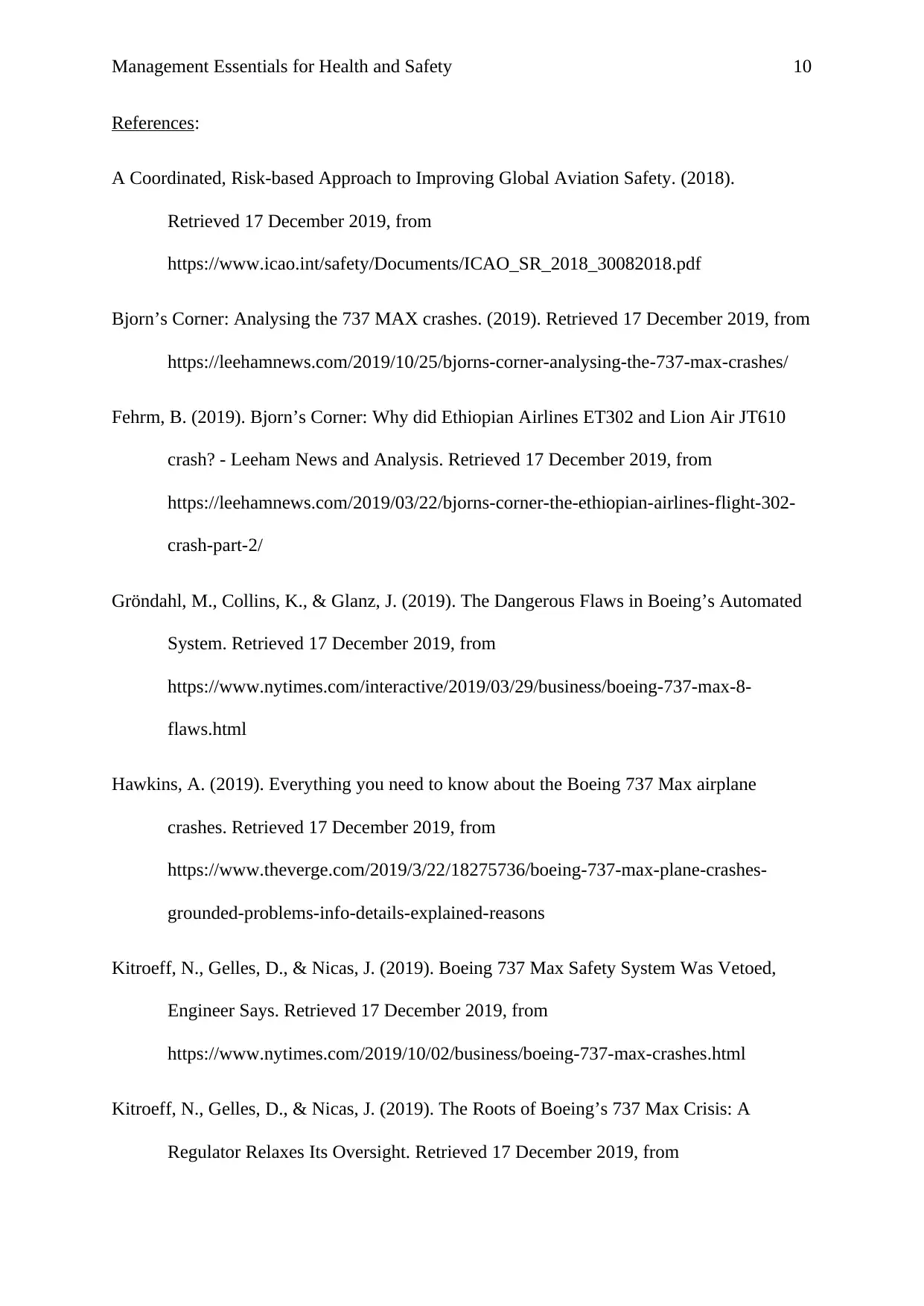
Management Essentials for Health and Safety 10
References:
A Coordinated, Risk-based Approach to Improving Global Aviation Safety. (2018).
Retrieved 17 December 2019, from
https://www.icao.int/safety/Documents/ICAO_SR_2018_30082018.pdf
Bjorn’s Corner: Analysing the 737 MAX crashes. (2019). Retrieved 17 December 2019, from
https://leehamnews.com/2019/10/25/bjorns-corner-analysing-the-737-max-crashes/
Fehrm, B. (2019). Bjorn’s Corner: Why did Ethiopian Airlines ET302 and Lion Air JT610
crash? - Leeham News and Analysis. Retrieved 17 December 2019, from
https://leehamnews.com/2019/03/22/bjorns-corner-the-ethiopian-airlines-flight-302-
crash-part-2/
Gröndahl, M., Collins, K., & Glanz, J. (2019). The Dangerous Flaws in Boeing’s Automated
System. Retrieved 17 December 2019, from
https://www.nytimes.com/interactive/2019/03/29/business/boeing-737-max-8-
flaws.html
Hawkins, A. (2019). Everything you need to know about the Boeing 737 Max airplane
crashes. Retrieved 17 December 2019, from
https://www.theverge.com/2019/3/22/18275736/boeing-737-max-plane-crashes-
grounded-problems-info-details-explained-reasons
Kitroeff, N., Gelles, D., & Nicas, J. (2019). Boeing 737 Max Safety System Was Vetoed,
Engineer Says. Retrieved 17 December 2019, from
https://www.nytimes.com/2019/10/02/business/boeing-737-max-crashes.html
Kitroeff, N., Gelles, D., & Nicas, J. (2019). The Roots of Boeing’s 737 Max Crisis: A
Regulator Relaxes Its Oversight. Retrieved 17 December 2019, from
References:
A Coordinated, Risk-based Approach to Improving Global Aviation Safety. (2018).
Retrieved 17 December 2019, from
https://www.icao.int/safety/Documents/ICAO_SR_2018_30082018.pdf
Bjorn’s Corner: Analysing the 737 MAX crashes. (2019). Retrieved 17 December 2019, from
https://leehamnews.com/2019/10/25/bjorns-corner-analysing-the-737-max-crashes/
Fehrm, B. (2019). Bjorn’s Corner: Why did Ethiopian Airlines ET302 and Lion Air JT610
crash? - Leeham News and Analysis. Retrieved 17 December 2019, from
https://leehamnews.com/2019/03/22/bjorns-corner-the-ethiopian-airlines-flight-302-
crash-part-2/
Gröndahl, M., Collins, K., & Glanz, J. (2019). The Dangerous Flaws in Boeing’s Automated
System. Retrieved 17 December 2019, from
https://www.nytimes.com/interactive/2019/03/29/business/boeing-737-max-8-
flaws.html
Hawkins, A. (2019). Everything you need to know about the Boeing 737 Max airplane
crashes. Retrieved 17 December 2019, from
https://www.theverge.com/2019/3/22/18275736/boeing-737-max-plane-crashes-
grounded-problems-info-details-explained-reasons
Kitroeff, N., Gelles, D., & Nicas, J. (2019). Boeing 737 Max Safety System Was Vetoed,
Engineer Says. Retrieved 17 December 2019, from
https://www.nytimes.com/2019/10/02/business/boeing-737-max-crashes.html
Kitroeff, N., Gelles, D., & Nicas, J. (2019). The Roots of Boeing’s 737 Max Crisis: A
Regulator Relaxes Its Oversight. Retrieved 17 December 2019, from
Paraphrase This Document
Need a fresh take? Get an instant paraphrase of this document with our AI Paraphraser

Management Essentials for Health and Safety 11
https://www.nytimes.com/2019/07/27/business/boeing-737-max- faa.html?
rref=collection%2Ftimestopic%2FBoeing%20Company
SCHAPER, D. (2019). FAA Finds New Problem With 737 Max Jets, Delaying Their Return
To Flight. Retrieved 17 December 2019, from
https://www.npr.org/2019/06/26/736430419/faa-finds-new-problem-with-737-max-
jets-delaying-their-return-to-flight
Terrifying final minutes of doomed Boeing 737 Max | 60 Minutes Australia. (2019). [Video].
Retrieved from https://www.youtube.com/watch?v=OxPsxmU_ocI
https://www.nytimes.com/2019/07/27/business/boeing-737-max- faa.html?
rref=collection%2Ftimestopic%2FBoeing%20Company
SCHAPER, D. (2019). FAA Finds New Problem With 737 Max Jets, Delaying Their Return
To Flight. Retrieved 17 December 2019, from
https://www.npr.org/2019/06/26/736430419/faa-finds-new-problem-with-737-max-
jets-delaying-their-return-to-flight
Terrifying final minutes of doomed Boeing 737 Max | 60 Minutes Australia. (2019). [Video].
Retrieved from https://www.youtube.com/watch?v=OxPsxmU_ocI
1 out of 11
Related Documents
Your All-in-One AI-Powered Toolkit for Academic Success.
+13062052269
info@desklib.com
Available 24*7 on WhatsApp / Email
![[object Object]](/_next/static/media/star-bottom.7253800d.svg)
Unlock your academic potential
Copyright © 2020–2025 A2Z Services. All Rights Reserved. Developed and managed by ZUCOL.





